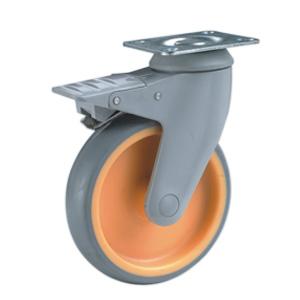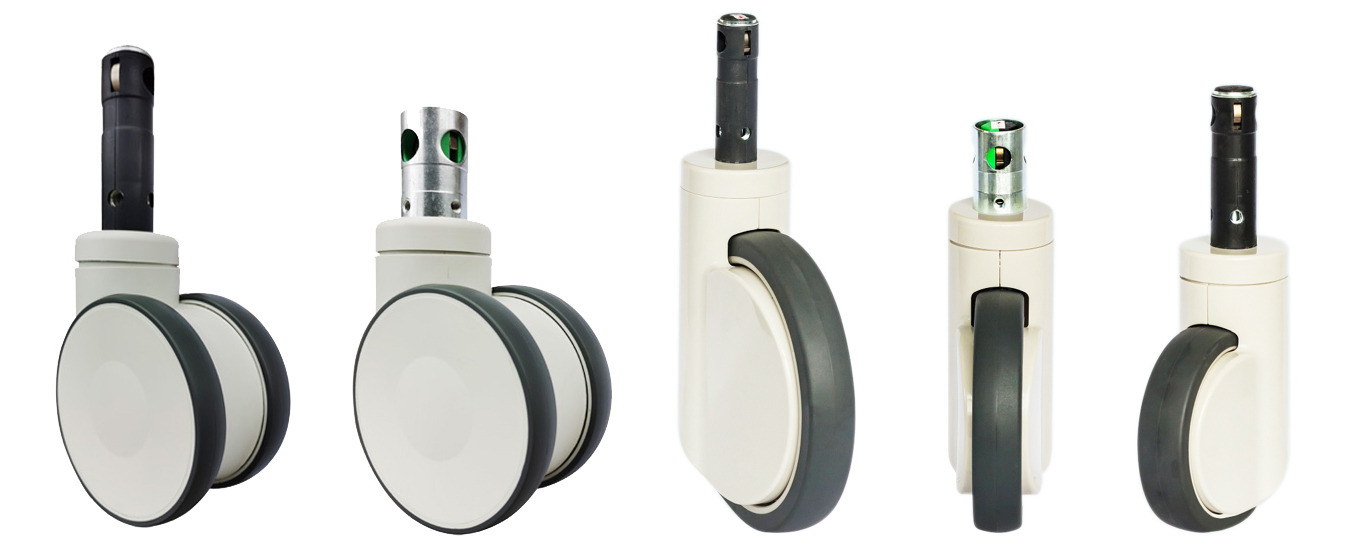Caster Swivel Lead Explained
WHAT IS LEAD AND WHAT ARE THE MOST IMPORTANT TYPES
In order to discuss swivel lead, it is important to first mention the different types of forks. A caster’s fork serves the purpose of holding the wheel and axle while connecting them to the top plate. Various devices with wheels, such as bicycles, utilize forks. When it comes to casters, there are three primary types of forks: rigid, standard-lead, and extended-lead.
The rigid fork is straightforward—it forms a 90-degree angle from the point where the wheel touches the ground.
Caster lead is found almost exclusively on swiveled casters.
To understand the standard-lead and extended-lead forks, it’s crucial to comprehend the concept of lead in caster swivels. Lead refers to the measurement from the center of the swivel to the vertical center-line of the wheel. In the case of a rigid fork, there is no lead as these two lines coincide (zero lead). However, when the fork angle is altered, a disparity arises between these two center-lines, resulting in lead.
The concept of lead can be observed in motorcycles and bicycles. For instance, envision a chopper—a type of motorcycle renowned for its distinctive extended front fork, which contributes to its noticeable lead.
With casters, there is no bible when it comes to leads. There is a smaller angle (and therefore smaller lead) that is referred to as a “standard-lead,” but this can vary slightly from manufacturer to manufacturer. A general measurement on 8-inch wheels is about 1 ½ to 2 ¼ inches (1.5” – 2.25”). Now, you can increase the angle, and therefore the lead. This is an “extended-lead”. With an 8-inch wheel, you’re looking at around 2 ¾ to 3 ½ inches (2.75” – 3.5”) on the lead. So, when talking about casters, you essentially are dealing with two leads, standard and extended.

Extended lead caster
With bikes of all sorts, they play with this angle to fine-tune your riding experience, but in the caster industry, we see mainly these two types, besides rigid. These are mainly found on swivel casters. So, what does changing the lead actually do?
RIGID FORKS AND ZERO LEAD
Before we provide a response, let’s consider the importance of strength. A rigid fork, with its zero lead, is the strongest option because it allows the weight to be pushed directly down on the fork. The greater the lead, the less weight the caster can support. With a rigid fork, we can support the most weight possible. However, in more demanding situations that involve extended leads, we may need to use thicker forks and more robust raceways on the caster to compensate for the decrease in weight capacity. Fortunately, we can adjust various parts of the caster to offset the loss of weight capacity. Nevertheless, it is important to understand that extended leads cannot handle as much weight as standard leads or rigid forks. It is crucial to consider this when choosing the appropriate caster for your application.

Rigid fork and zero caster lead.
If we can adjust parts of the rig, at times, to compensate for the dropped weight capabilities, what is the main purpose of rigid forks? An important reason is because of the different maneuverability options we have when we combine different types of forks/rigs. It is much easier to maneuver swivel rigs than rigid ones. However, rigid rigs help you to stay on track and in a straight line, so we need to balance the two. See examples of caster wheel arrangements here.
Another feature of rigid forks is that they have the smallest turning radius of all forks. When you extend the lead, your turning radius increases. So, when we’re concerned with making sharp turns or stacking carts in close proximity, we need to make sure that our turning radius won’t impact this. This is important for both manual and powered applications. With this in mind, we can examine what advantages you get with an extended rig.

EXTENDING THE LEAD
When we extend the lead, we need to remember that this doesn’t solve all of our problems. It gives us choices, but we need to use the proper caster lead to the proper application. With this in mind, here is how you will be affected when you change the lead of your casters.
Now, a regular standard-lead is of course extended from a rigid, but you really gain the most benefits when you go to a true extended-lead. For example, when you use an extended-lead, it will almost always immediately reduce push/pull by 10 to 50 percent. You, in one moment, reduce the chance of injury to your employees who are pushing or pulling carts, in addition to extending the life of all of your equipment. How does an extended-lead accomplish this?
We exert the greatest amount of effort when we push the cart initially. An object remains in motion easier than it begins this motion. Wheels are also almost always turned when at rest, that is, not in the trailing position. You have to push the cart to straighten these wheels out. In other words, everything’s stacked against you when you push the cart initially. Extended-lead casters allow the wheels to easily swing into position so that you don’t have to slip a disc in your back every time you want to get those thousands of pounds moving.
This smooth start with the extended-lead also reduces strain on the entire caster itself. There is no grinding or catching, so you will extend the life of your caster. That means less downtime and less maintenance but also more productivity and time for you.
As mentioned earlier, an extended-lead facilitates easier movement of the wheel to the trailing position. It also significantly improves the ability of the cart to track in a straight line, thereby reducing caster flutter. This is especially crucial in applications involving high speeds or towlines. Think about the wobbly-wheeled carts at a supermarket that nobody prefers. Would you want your valuable, heavy product placed on such an unstable cart? By extending the lead, this tendency can be eliminated in most cases.
By ensuring a stable cart, you not only protect your product but also relieve your employees from concerns about an unsteady cart. This becomes particularly important in towline systems and high-speed operations. Additionally, there are resource-saving benefits as you won’t need to exert extra effort pulling a cart that wobbles. Furthermore, noise levels are dramatically reduced since there is no fluttering or loose parts caused by constant shaking. Whether you have dozens of carts or just one, implementing an extended-lead design results in a significant reduction in noise. Your cart will become as quiet as a mouse.
Now that you understand leads, what do you do with the info? If you already have carts and casters, take a look and see how many of them have extended-leads. If many of them do not, you might need to look into adding more extended-leads. If you have extended-leads, do the raceway and fork provide you with enough strength. If you haven’t ordered them yet, then make sure to match the fork, raceway, and wheel properly to give yourself the best and most trouble-free experience possible.
To order your central-locking brake system or to have any questions answered, please click here.
Product Tag:central locking casters

